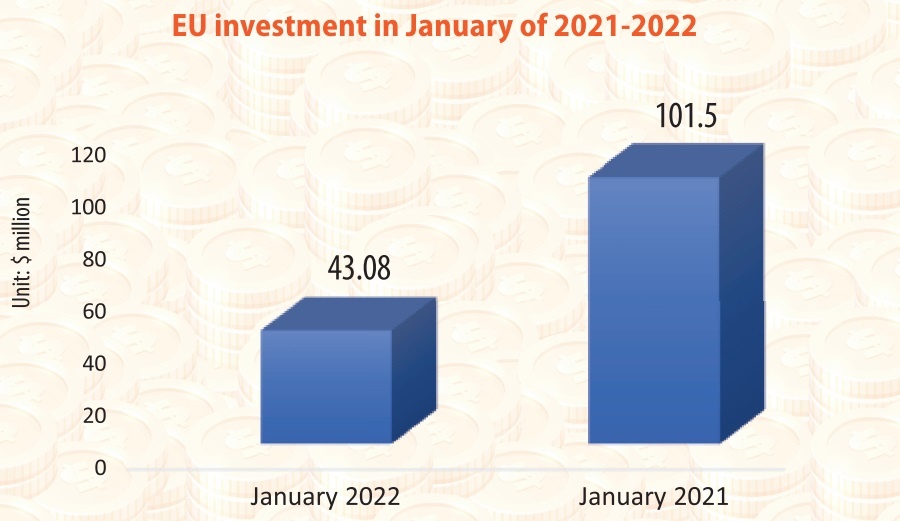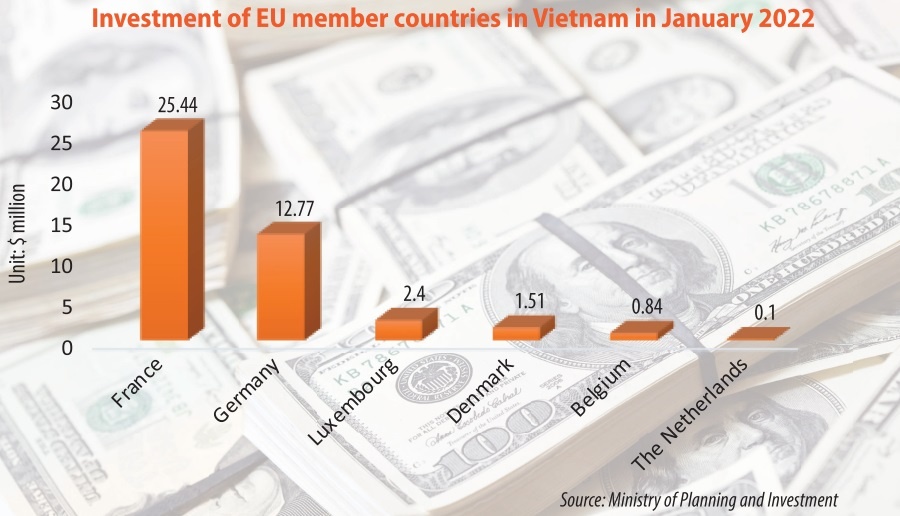High-tech EU investment shows promise
In late January, a working group of the European Chamber of Commerce in Vietnam (EuroCham) led by vice chairman Jean-Jacques Bouflet visited the southern province of Binh Duong to work on business and investment opportunities.
Bouflet said he believes in the province’s future development. Although COVID-19 has caused serious impacts, almost all EU businesses in the province have resumed their operations. He reaffirmed that Binh Duong is one of the three most important localities in EuroCham’s cooperation programme in Vietnam.
Binh Duong, one of the country’s top foreign investment destinations, is now looking for further EU investment in green economy, sustainable business, financial services, energy, and logistics.
EuroCham chairman Alain Cany told VIR, “Europe contains some of the world’s leading companies in high-tech industries as well as green and sustainable businesses. We know that the Vietnamese government is prioritising attracting foreign direct investment (FDI) in such industries, and 2022 should see significant opportunities for greater inflows from the EU.”
Promising signals came for such funding attraction when in the first month of 2022, the Ministry of Planning and Investment (MPI) announced that Vietnam gained $2.1 billion worth of FDI, up 4.2 per cent on-year, of which foreign-invested enterprises increased $1.27 billion in their existing projects, up 2.69 folds from the same period last year.
The increase is contributed through large investment from EU member countries. For instance, French funding in Vietnam in January alone reached $25.44 million, up from $2.28 million in January last year. German investment in Vietnam hit $12.77 million during the period, compared to $0.96 million in the same month of 2021.
Last year, members of EuroCham suffered significant setbacks in their commercial operations with lockdowns, travel restrictions, and social distancing inhibiting international trade and investment. During last year, the focus for European businesses was to weather the storm of the pandemic. And the most positive aspect of EU-Vietnam trade and investment last year was the initial success of the EU-Vietnam Free Trade Agreement (EVFTA).
 |
 |
Portraying confidence
As shown in the latest Business Climate Index – a regular barometer of European business leaders and investors from EuroCham – European companies ended 2021 more optimistic about Vietnam’s trade and investment environment.
As many as 43 per cent plan to increase their investment in the first quarter of 2022, compared to just 17 per cent three months ago. Likewise, more than one-third (38.5 per cent) intend to increase their headcount, up around 15 per cent, while over half (51.5 per cent) are predicting a rise in orders and revenue, a rise of 7.5 per cent compared to Q3.
Alexander Goetz, chairman of the German Business Association, believes many investors are ready to reschedule their visits to Vietnam in the first half of 2022. “Nearly 50 per cent of German companies in Vietnam have planned to expand their business to diversify their supply chain, hence reducing the dependency on China,” Goetz said. “The current investment trend of German companies still focuses on industrial strengths such as manufacturing and technical processing and services. Besides those, we also think that sustainable energy and infrastructure solutions are segments with a very high potential for future investments.”
According to Nguyen Van Toan, vice chairman of the Vietnam Association of Foreign-Invested Enterprises, several factors have supported the January rebound – from the government’s supporting policies for businesses and efforts to further improve the business climate, to the resumption of international commercial flights and change to the pandemic strategy. “These ease the constraints and solve bottlenecks for an economic bounce back, and will also facilitate the growth in 2022,” Toan said.
Now, Vietnam wants to do more with bolder actions to boost the economic recovery. On January 10, the government issued Resolution No.02/NQ-CP on the key tasks and solutions to improve the business environment and national competitiveness in 2022 in a move to achieve the socioeconomic development targets set for 2022 and the 2021-2025 period, while supporting business recovery and development.
This year the country aims to increase the indexes of the business environment, national competitiveness, and national credit rating by Moody’s, S&P, and Fitch; improve the Control of Corruption index by 10 notches; and improve the index of land administrative management quality to at least one notch, among others.
To this end, 10 key tasks have been assigned to ministries and agencies to solve the issues of special concerns among foreign businesses, including those from the EU. The tasks include cutting the list of conditional business sectors and conditions; removal of business and investment barriers caused by overlapping of legal documents; reform of specialised checks for imports and exports; and reform of land registration and land administrative management.
Also on the task list is acceleration of digital transformation, further intensification of administrative reform, promotion of sustainable development, supporting policies for business recovery, and intensification of international cooperation aligned with the improvement of the local business climate and national competitiveness.
Predictable environment
In addition to Resolution 02, the government on January 30 issued Resolution No.11/NQ-CP on the Programme on Economic Recovery and Development, and implementation of Resolution No.43/2022/QH15 on the fiscal policy to support the programme with an aim to achieve the targets of GDP growth of 6.5-7 per cent annually during 2021-2025, keeping the unemployment rate in urban areas at below 4 per cent, and keeping macro-economy stable.
Under the programme, VAT will be reduced from 10 per cent to 8 per cent from 2022. Meanwhile, environmental protection tax will be cut by 50 per cent for flying fuel. Land rental will be reduced by 30 per cent and there will be a 50 per cent cut in registration fees for cars locally manufactured or assembled, among others. A 2-year interest rate support will also be offered in 2022-2023 for businesses in aviation, tourism, education and training, agriculture, manufacturing and processing industry, software production, and others.
“European investors want a predictable, stable, and competitive trade and investment environment. Therefore, continued simplification of admin procedures and an accelerated streamlining of business conditions would help to spur new investment and encourage more European enterprises to set up or grow their footprint here,” said EuroCham executive director Delphine Rousselet.
“Likewise, a further reduction in conditional business sectors would open up new industries not just to European investment but also to European innovation. Meanwhile, further legal reforms in the fields of public-private partnership would help to fuel Vietnam’s adoption of cleaner, greener, more sustainable power generation through EU investment and knowledge transfer,” Rousselet added.
Industry insiders said that the EVFTA has made a strong start in its first 18 months, with EU companies now benefiting from a gradual elimination of tariffs and a mutual opening of markets. This is a significant magnet for European investors who want to access not just Vietnam, but also to take advantage of its strategic position as a manufacturing hub in the ASEAN region.
This attraction will be boosted even further once the EU-Vietnam Investment Protection Agreement enters into force, after approval by all EU member states. It aims to give investors greater confidence and better protection for capital contributed to the market through an innovative dispute-resolution mechanism and other guarantees.
What the stars mean:
★ Poor ★ ★ Promising ★★★ Good ★★★★ Very good ★★★★★ Exceptional
 Tag:
Tag:
Related Contents
Latest News
More News
- KK Group opens global flagship store in Ho Chi Minh City (January 19, 2026 | 11:52)
- Gia Lai draws over $1bn in new investment so far this year (January 19, 2026 | 11:50)
- Unlocking capital flows for strategic and suitable projects (January 18, 2026 | 09:00)
- ACV begins cargo terminal construction at Danang Airport (January 17, 2026 | 15:57)
- Viettel starts construction of semiconductor chip production plant (January 16, 2026 | 21:30)
- Bel expands Vietnam production with $19.7 million investment (January 16, 2026 | 16:07)
- ASML signals long-term commitment to Vietnam (January 16, 2026 | 12:00)
- Ho Chi Minh City starts construction of four key infrastructure projects (January 15, 2026 | 17:22)
- PIDG invests with AquaOne to expand Xuan Mai’s treated water supply to Hanoi (January 15, 2026 | 11:16)
- Vietnam ranks 38th in global AI adoption (January 14, 2026 | 16:01)






















 Mobile Version
Mobile Version